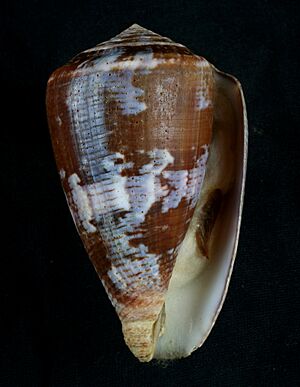Conus purpurascens facts for kids
Quick facts for kids Conus purpurascens |
|
|---|---|
 |
|
| Shell of Conus purpurascens G. B. Sowerby I, 1833, with operculum, measuring 83.7 mm in height, collected at low tide on Venudo Island, in Panama | |
| Conservation status | |
| Scientific classification | |
| Synonyms | |
|
The purple cone (scientific name: Conus purpurascens) is a type of sea snail. It's a marine gastropod mollusk, which means it's a snail that lives in the ocean. This snail belongs to the Conidae family, also known as the cone snails.
Just like other cone snails, the purple cone is a predatory animal, meaning it hunts other creatures for food. It's also venomous, so it can "sting" humans. Because of this, it's very important not to touch live purple cone snails. Scientists have even found a special toxin called Conantokin-P in its venom.
What Does It Look Like?
The shell of the purple cone snail can be anywhere from about 33 mm (1.3 inches) to 80 mm (3.1 inches) long. It has wide "shoulders" and a rough, ridged spire (the pointed top part of the shell).
The shell often has stripes or lines on the bottom. Its colors are a mix of white or purplish shades, along with brown or olive green. You might see thin lines of chestnut brown and tiny white patterns. Sometimes, there's also an irregular white band around the middle of the shell. Even though the colors can vary a lot, the overall shape of the shell stays pretty much the same.
Where Does It Live?
You can find the purple cone snail in the central Pacific Ocean. It lives off the coast of the Galapagos Islands and in the Gulf of California, which is near Mexico.


